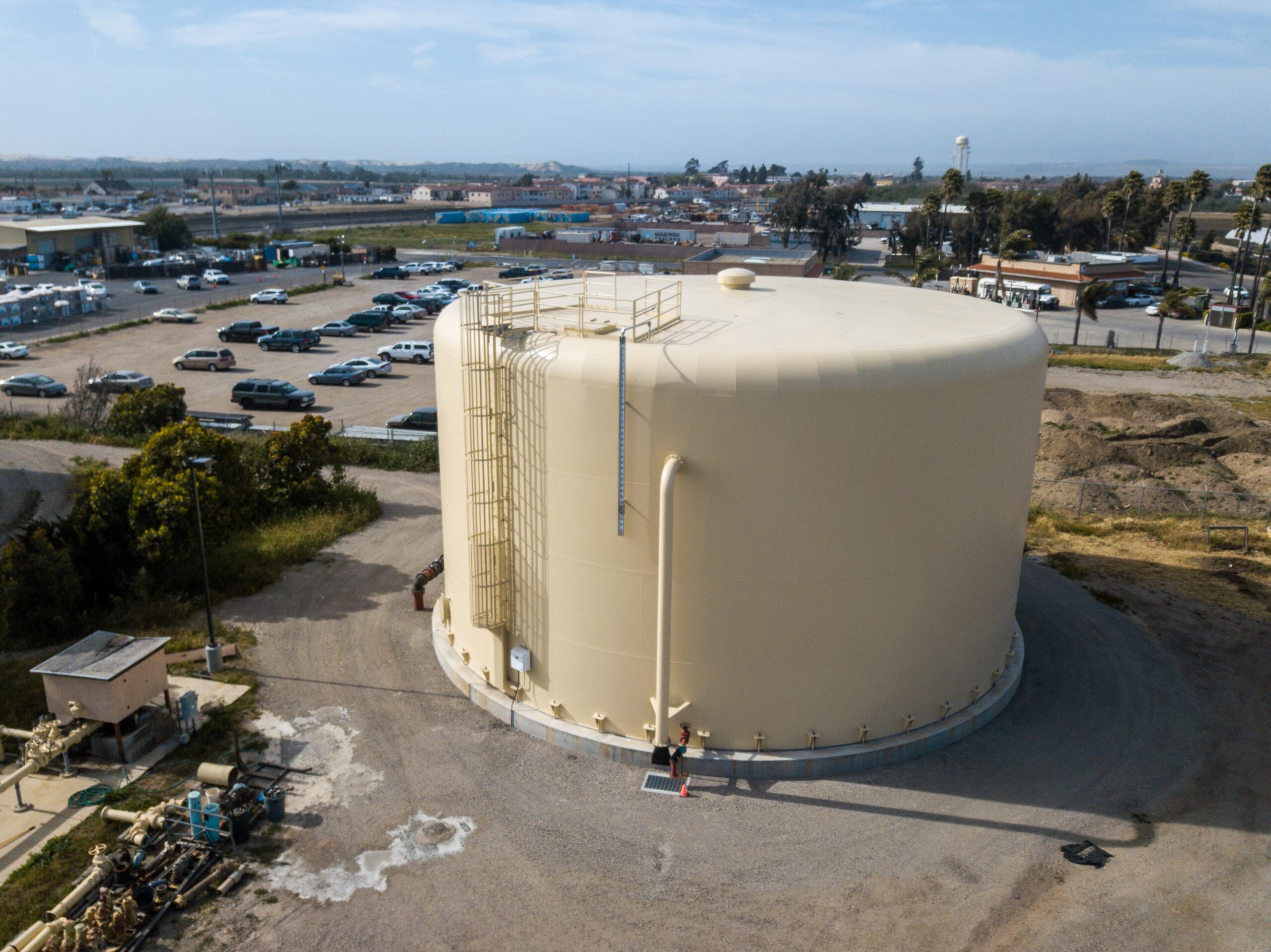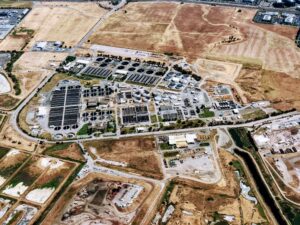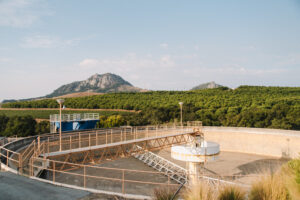
What is a tank?
A tank is a storage facility for fluids, either liquid or gas. Civil Engineers often refer to liquid storage structures in distribution systems as reservoirs.
Where do we find tanks?
Tanks are often found in municipal distribution systems, supplying water to customers, providing operational flexibility, and meeting emergency and fire flow demands. Tanks are also found at water and wastewater treatment plants, or in collection systems, to capture and retain stormwater flows or unusually high wastewater flows. They can also be used in industrial applications to store chemicals for a variety of processes.
Tanks have a variety of uses in the water industry:
- Fluid storage (Holding supply and meeting specific demands – i.e. operational, emergency, and fire suppression)
- Maintaining specific pressure zones
- Energy conservation and efficiency (using gravity vs. continuous pumping & limiting pump start/stops)
- Flow equalization
- Mixing and blending fluids
- Specific water treatment processes
- Achieving chlorine contact time
- Redundancy/operational flexibility
- Capturing and retaining stormwater
- Surge relief applications
Structure Types
Project needs, application, and owner familiarity and preferences often inform the type of tank to be used.
- Elevated tanks use either welded steel or a composite material; these water towers are often seen in areas with generally flat topography.
- Municipal ground storage tanks are typically welded steel (AWWA D100), bolted steel (AWWA D103), prestressed concrete (AWWA D110), or conventional reinforced concrete.
- Chemical/industrial tanks are often made of fiberglass or polyethylene as they typically hold smaller volumes and contain fluids more corrosive than water.
- Buried or partially buried tanks are designed/constructed using precast, prestressed or conventionally reinforced concrete, though some composite materials can be used. These tanks may store potable or non-potable water, stormwater basins, process tanks (clarifiers, contact basins, etc.), and wet wells.
Factors for Consideration
What fluid needs to be stored?
In the Civil/Environmental Industry, we most often see tanks required for water storage (raw, potable, recycled, wastewater, and stormwater). Clients may need to store other liquids or gasses, and there may also be a need for pressurized or non-pressurized vessels. Wastewater and sludge can create a corrosive environment within a tank.
What capacity is needed?
Smaller volumes may only require pre-manufactured systems such as plastic (HDPE, FRP, etc.) or precast concrete. Larger storage requirements tend to require more intensive design for a unique steel or concrete structure. Geotechnical parameters, client preferences, hydrostatic and hydrodynamic concerns must always be considered.
What is the site’s geography?
Terrain plays a key factor in deciding what type of tank will work best. Our checklist includes earthwork and backfill requirements, high seismicity, wind loading, soil corrosivity, aesthetic issues, and geotechnical concerns.
What are the clients’ objectives with the finished project?
Every client has unique goals for their project. This could be prioritizing capital costs, maintenance costs, tight schedules, ease of access, competition, or aesthetics.
Tank Capacities
“Smaller tanks” in our industry typically hold 100,000 gallons or less of fluid. Though they are typically less complex, they can still be challenging to design and construct. For aboveground structures, bolted steel and welded steel tanks are very common. Site constraints and volume requirements may necessitate the need for a cast-in-place concrete structure.
Medium-sized tanksin our industry are often considered as having volumes between 100,00 to 1 million gallons. For above ground storage, welded steel tanks are the most common. Owner preferences, type of fluid, and site constraints may also warrant the use of concrete (precast, circular or irregular shaped cast-in-place, or prestressed).
Larger Tanks are typically 1 million gallons and over in capacity. Welded steel tanks are a viable option, however future maintenance projects (re-coatings) may result in a higher total cost of ownership. Corrosion protection of welded steel structures becomes an important factor. Prestressed concrete benefits from economy-of-scale and typically provides a lower total cost of ownership as capacity increases. Prestressed concrete is also ideal for buried/partially buried applications – as wall thicknesses are usually substantially thinner that what is required for conventional concrete. Conventional reinforced concrete is also ideal for buried applications or non-circular shaped tanks, however these structures require detailed structural design and cannot be specified with performance requirements.
Steel Vs. Concrete
Steel (bolted and welded) is the most common material for water retaining structures. These tanks are leak-free with a low capital cost and quick construction time. Although costs can add up depending on the size and complexity, steel tanks are generally easy to rehabilitate, repurpose, or modify. With regular, routine maintenance (15-25 year re-coating), they have a design life of 100+ years.
Concrete tanks, though more capital cost intensive, typically have a lower total cost of ownership (especially at larger capacities). They require minimal maintenance, no coatings (depending on the fluid stored), and have proven seismic resilience. Concrete also allows for the tank to be used as a retaining structure if required. Concrete tanks also have a long design life of 75 to 100+ years.







